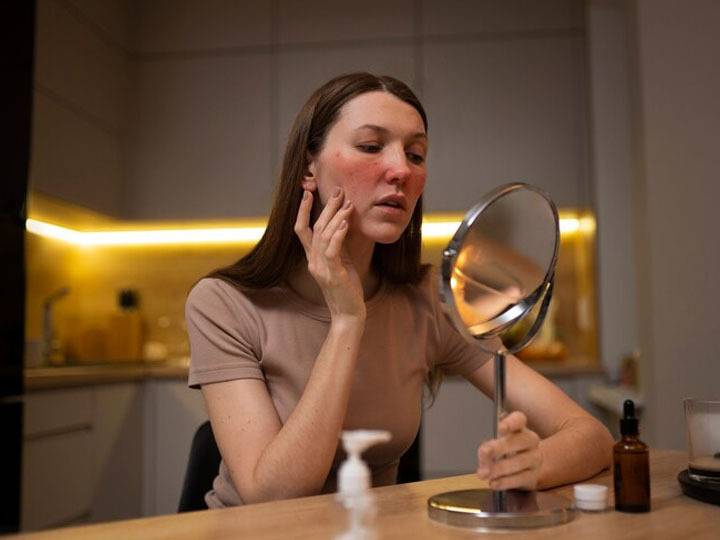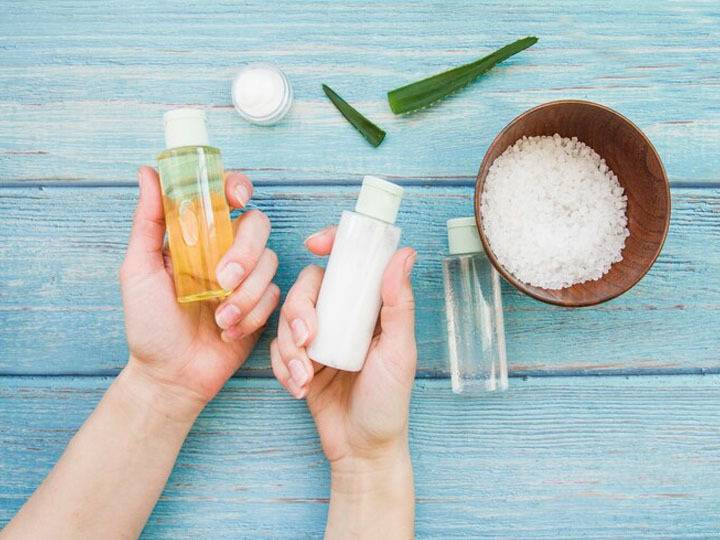The sequence in which you apply your skincare products is significant, whether you prefer a straightforward 3-step morning routine or a comprehensive 10-step regimen in the evening.
Why is this important? A skincare routine becomes less effective if the products do not have the opportunity to penetrate your skin properly.
Continue reading to discover effective layering techniques for maximum impact, identify steps you can omit, explore recommended products, and gain additional insights.
Step 1: Oil-based cleanser

- What is it? Cleansers are available in two forms: water-based and oil-based. The latter is formulated to dissolve the oils produced by your skin.
- How to use it: Some oil-based cleansers are designed to be used on wet skin, while others work best on dry skin. Before applying, read the instructions, apply a small amount to your skin, massage it in, and rinse thoroughly with water before drying with a clean towel.
- Skip this step: if your cleanser contains only oil, without surfactants and emulsifiers, especially if you have combination or oily skin. Using cleansing oils may lead to increased oiliness.
- Be sure to: Conduct a patch test in a small area on your skin for a few days and observe how your skin reacts. If you experience cystic acne, consult with your dermatologist before transitioning to an oil-based cleanser.
- Pros: Oil cleansers can provide thorough cleansing, unclogging pores, and effectively removing even waterproof makeup. A small 2019 study suggests that oil cleansers may be more effective in removing waterproof sunblock compared to other methods.
- Cons: Anecdotal evidence suggests that there may be an initial 1- to 2-week “purging” period during which you might experience breakouts as old oil on your skin is cleansed.
Step 2: Water-based cleanser

- What is it? These cleansers primarily feature surfactants, which are ingredients enabling water to effectively rinse away dirt and sweat. Additionally, they have the capability to eliminate the oils removed by an oil-based cleanser.
- How to use it: Apply to wet skin, massage, and then rinse thoroughly with water before drying.
- Skip this step if: You prefer not to engage in a double cleansing routine or if your oil-based cleanser already contains surfactants that adequately eliminate dirt and debris.
- Be sure to: Seek a cleanser with a neutral or low pH, as it may be less irritating to your skin.
- Pros: Gentle water-based cleansers can be advantageous in preventing breakouts, particularly for those with acne-prone or oily skin.
- Cons: More abrasive surfactants have the potential to dry out your skin and may compromise its natural barrier.
Step 3: Toner or astringent

- What is it? Toners are formulated to hydrate and replenish the skin while eliminating dead cells and residual dirt post-cleansing. On the other hand, an astringent is an alcohol-based product employed to remove excess oil.
- How to use it: Immediately after cleansing, either apply directly to the skin or onto a cotton pad and then swipe it over the face in an outward motion.
- Skip the astringent if: You have dry skin.
- Be sure to: Avoid toners with high alcohol content, as they can be irritating to the skin.
- Pros: Toners and astringents can contribute to reducing the appearance of pores and removing impurities left behind after cleansing.
- Cons: Excessive use of alcohol-based toners can lead to skin irritation.
Step 4: Antioxidant Serum

- What is it? Serums boast a high concentration of specific ingredients, and an antioxidant-infused serum serves to shield the skin from damage caused by unstable molecules known as free radicals. Common antioxidants such as Vitamins C and E are utilized to enhance texture and firmness, while others like green tea, resveratrol, and caffeine are also beneficial.
- How to use it: Gently pat a few drops onto your face and neck.
- Be sure to: Conduct a patch test in a small area to assess how the product interacts with your skin and with other items in your skincare routine.
- Pros: Antioxidant serums can effectively reduce redness, wrinkles, and damage to your skin.
- Cons: Some serums, particularly those containing acids, may cause irritation when combined with other acid-containing skincare products
Step 5: Spot treatment

- What is it? When dealing with a blemish with a visible head, begin by seeking an anti-inflammatory product to address it, followed by a spot-drying treatment to address the remaining concerns. Anything beneath the skin is categorized as a cyst and requires a product targeting the internal infection.
- How to use it: Use a damp cotton swab to eliminate any skincare products from the affected area. Apply a small amount of the treatment and allow it to dry.
- Skip this step if: You don’t have any blemishes or prefer to let the natural healing process take its course.
- Products to try: Kate Somerville EradiKate Acne Treatment, with its high sulfur content, effectively reduces spots and prevents new pimples. Murad Rapid Relief Acne Spot Treatment is also suitable for daytime use. It dries clear, expediting the healing process and assisting with residual discoloration.
- Be sure to: Refrain from using spot treatment on open blemishes.
- Pros: Acne treatments can alleviate inflammation, redness, and discomfort.
- Cons: Skin reactions may occur, especially with products containing potent ingredients. Introduce a new product gradually and monitor its effects on your skin.
Step 6: Eye Cream

- What is it? The skin around your eyes is typically thinner and more delicate, making it susceptible to signs of aging like fine lines, puffiness, and darkness. While a good eye cream can brighten, smooth, and firm up the area, it’s important to note that it won’t completely eliminate these concerns.
- How to use it: Gently dab a small amount onto the eye area using your ring finger.
- Skip this step if: Your moisturizer and serum are suitable for the eye area, possess an effective formula, and are fragrance-free.
- Be sure to: Apply only a small amount and cleanse the area thoroughly. Neglecting to remove product buildup from this delicate area may lead to clogged pores.
- Pros: Eye creams are formulated for the sensitive skin around your eyes and can contribute to reducing signs of aging, such as wrinkles and discoloration.
- Cons: If the eye cream comes into contact with your eyes, it may cause irritation.
Step 7: Lighter face oil

- What is it? The rule of thumb is to apply lighter products earlier in your routine. Lightweight and easily absorbable oils should precede moisturizer, particularly if your skin is exhibiting dryness, flakiness, or dehydration.
- How to use it: Dispense a few drops onto your fingertips, gently rub them together to warm the oil, and then lightly dab it onto your face.
- Skip this step if: You prefer a simpler skincare routine. It’s often necessary to experiment with different oils to determine which works best for your skin.
- Products to try: Aspen Kay Glow Face Oil is effective for treating dry skin, while The Ordinary Cold-Pressed Rose Hip Seed Oil is specifically formulated to reduce signs of photoaging.
- Be sure to: Allow the oil to fully absorb before applying sunscreen, as certain face oils may compromise the effectiveness of your sunscreen.
- Pros: Face oils assist in locking in hydration, ensuring your skin remains moisturized.
- Cons: Oils may lead to breakouts, especially for individuals with oily skin.
Step 8: Moisturizer

- What is it? A moisturizer is designed to calm and soften the skin. For dry skin types, cream or balm formulations are recommended, while thicker creams are suitable for normal or combination skin. Fluids and gels are preferable for oilier skin types, and effective ingredients include glycerine, ceramides, antioxidants, and peptides.
- How to use it: Take a slightly larger than pea-size amount, warm it in your hands, and apply to the cheeks first, followed by the rest of the face using upward strokes.
- Skip this step if: Your toner or serum provides sufficient moisture, particularly for those with oily skin.
- Be sure to: Apply moisturizer with clean hands, especially if using it from a jar that requires dipping your fingers. Using dirty hands may introduce dirt and bacteria into your moisturizer.
- Pros: Regular moisturizing can contribute to preventing blemishes and other skin issues by safeguarding your skin’s barrier.
- Cons: Using a moisturizer that is too heavy without proper cleansing may lead to the development of milia—small white bumps—on your skin.
Step 9: Heavier face oil

- What is it? Oils that take some time to absorb or feel thick are classified as heavy. Best suited for dry skin types, these oils should be applied after moisturizer to lock in all the beneficial properties.
- How to use it: Follow the same application process as you would for lighter oils.
- Skip this step if: You want to avoid the possibility of clogging your pores. Once again, trial and error is essential.
- Be sure to: Thoroughly cleanse your face at the end of the day, as heavier face oils may contribute to pore clogging.
- Pros: These oils effectively moisturize your skin and seal in hydration from previous steps in your skincare routine.
- Cons: Heavier oils may lead to breakouts, especially for individuals with acne-prone skin.
Step 10: Sunscreen

- What is it? Sunscreen plays a crucial role as the final step in your morning skincare routine. Not only does it decrease the risk of skin cancer, but it also combats signs of aging by blocking harmful UV light. The American Cancer Society recommends selecting a broad-spectrum sunscreen with an SPF rating of 30 or higher, providing protection against both UVA and UVB light.
- How to use it: Apply generously to your face, massaging it in. Ensure application 15 to 30 minutes before going outdoors. Never layer other skincare products on top, as it may dilute the effectiveness of the sunscreen.
- Be sure to: Reapply sunscreen to your face and body every 2 hours when spending time in the sun.
- Pros: Incorporating sunscreen along with additional precautions like wearing a hat and seeking shade can effectively reduce the risk of skin cancer.
- Cons: Some sunscreens may trigger skin reactions, so it’s crucial to conduct a patch test in a small area before applying over the entire body. Additionally, certain formulas may be unsafe for marine life, such as coral reefs, if you plan to swim in the ocean. Reading the label is essential to determine the most suitable product for your needs.
Step 11: Foundation or other base makeup

- What is it? For those desiring makeup, a base layer is essential to achieve a smooth and even complexion. Choose between foundation, available in cream, liquid, or powder forms, or opt for a lightweight tinted moisturizer or BB cream.
- How to use it: Apply makeup using a brush or sponge, starting from the center of the face and blending outward. For seamless blending at the edges, use a damp sponge.
- Skip this step if: You prefer a natural look.
- Be sure to: Check your foundation’s expiration date, as many last for 6 to 12 months from the date of first use.
- Pros: Foundations offer varying levels of coverage, from light to heavy, addressing blemishes, uneven tone, and more.
- Cons: Wearing makeup can lead to breakouts in some individuals.
Conclusion
Establishing a well-organized skincare routine is crucial for reaping the maximum benefits from your products. The carefully orchestrated sequence ensures effective penetration, addressing specific skin concerns at every step. From the initial use of oil-based cleansers to the final touch of sunscreen and makeup, each product serves a unique purpose in nurturing your skin.
The multi-step process, whether condensed or expansive, allows for customization based on individual skin types and concerns. It’s essential to be mindful of personal preferences and adapt the routine accordingly, omitting or emphasizing certain steps as needed.
Navigating through cleansers, toners, serums, spot treatments, and moisturizers, culminating in the vital application of sunscreen, establishes a holistic approach to skincare. The incorporation of antioxidants, tailored treatments, and the right oils contributes to a comprehensive regimen that addresses diverse skincare needs.
Ultimately, the goal is not just to follow a routine but to tailor it to your skin’s unique requirements. Regularity, patience, and adaptability are key as you embark on the journey to healthier, radiant skin.






